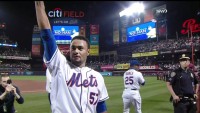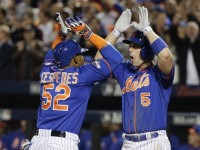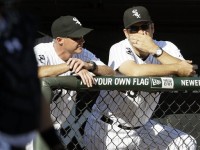Terry Collins

I have a bone to pick with Sandy Alderson. No, it’s not the offense that isn’t hitting. They should hit eventually. Well, we at least hope they will. No, it’s when Alderson dubbed Mets fans “Panic City.”
Let’s remember the context of that gem. The Mets were one game over .500, lost six of their last 10, and were 3.5 games behind the Nationals. They had allowed 14 more runs than they had scored. The Mets had scored the third fewest runs in baseball. The Mets had gone from seven games over .500 with a 4.5 game lead in the division (5.0 games over the Nationals) to falling in the standings. The Nationals were hot, and they were getting better. The Mets were seemingly falling apart while their General Manager was mocking the fans.
Funny thing is the Mets got worse offensively after that. It got to the point where fans were EXPECTING Clayton Kershaw to pitch a perfect game. Not too long after that, the Mets got healthy, made some trades, ran into a cushy August schedule, and they took off. Panic City was forgotten.
Until now.
The Mets are grossly underperforming now. In five of the Mets six games, they’ve scored three runs or less. Terry Collins is batting low OBP guys in front of high OBP guys, and he’s stacking lefties (yes, with Neil Walker‘s L/R splits, he’s effectively a lefty). Mets fans are annoyed as well they should be. But no, that’s not how it’s characterized. Because of Alserson’s comments, we’re “panicking”:
Collins on #PanicCity fretting #Mets' 2-4 start: "It's drama here. It's not drama in Milwaukee. It's not drama in Houston. It's drama here."
— Anthony DiComo (@AnthonyDiComo) April 12, 2016
can't believe the panic i'm hearing out of ny/nj/conn over 2-5. mets will be fine.
— Jon Heyman (@JonHeyman) April 13, 2016
Panic City, assemble!
— Matt Ehalt (@MattEhalt) April 10, 2016
Everybody’s a comedian.
Look, no matter what happens from here on out whenever the Mets have a tough stretch this fan base is going to be mocked for panicking. Honestly, I do not know one Mets fan panicking. Not one. I know if people raising legitimate concerns about a lineup that strikes out a lot and doesn’t have high OBP. But that’s not panic, that’s reality.
I haven’t heard one person declare the season over, demand a trade, or call for Collins to be fired. There’s no panic. There’s just really justifiable frustration over a team that’s not hitting, losing to bad teams, and wasting some good pitching performances. No, Mets fans are colored as being unreasonable and overly reactionary.
We will never see the article about how right the Mets fans were in 2015. We will not see how that the fans were 100% right in their complaints. We will not see how the fans were right about demanding that Michael Conforto be called up. However, we will see articles and tweets demeaning the fanbase once again calling them “Panic City” as if Mets fans should enjoy really bad offensive baseball.
It’s all because Alderson thought he was hilarious in demeaning Mets fans one day when they were irritated watching an inept offensive club ruining start after start. Apparently, realizing a team that finds runs hard to come by is panicking. A fan base that wants their General Manager is panicking. Apparently, not being happy with a team playing poorly against a weak early schedule is panicking.
Thanks for that Sandy.

I have a bone to pick with Sandy Alderson. No, it’s not the offense that isn’t hitting. They should hit eventually. Well, we at least hope they will. No, it’s when Alderson dubbed Mets fans “Panic City.”
Let’s remember the context of that gem. The Mets were one game over .500, lost six of their last 10, and were 3.5 games behind the Nationals. They had allowed 14 more runs than they had scored. The Mets had scored the third fewest runs in baseball. The Mets had gone from seven games over .500 with a 4.5 game lead in the division (5.0 games over the Nationals) to falling in the standings. The Nationals were hot, and they were getting better. The Mets were seemingly falling apart while their General Manager was mocking the fans.
Funny thing is the Mets got worse offensively after that. It got to the point where fans were EXPECTING Clayton Kershaw to pitch a perfect game. Not too long after that, the Mets got healthy, made some trades, ran into a cushy August schedule, and they took off. Panic City was forgotten.
Until now.
The Mets are grossly underperforming now. In five of the Mets six games, they’ve scored three runs or less. Terry Collins is batting low OBP guys in front of high OBP guys, and he’s stacking lefties (yes, with Neil Walker‘s L/R splits, he’s effectively a lefty). Mets fans are annoyed as well they should be. But no, that’s not how it’s characterized. Because of Alserson’s comments, we’re “panicking”:
Collins on #PanicCity fretting #Mets' 2-4 start: "It's drama here. It's not drama in Milwaukee. It's not drama in Houston. It's drama here."
— Anthony DiComo (@AnthonyDiComo) April 12, 2016
can't believe the panic i'm hearing out of ny/nj/conn over 2-5. mets will be fine.
— Jon Heyman (@JonHeyman) April 13, 2016
Panic City, assemble!
— Matt Ehalt (@MattEhalt) April 10, 2016
Everybody’s a comedian.
Look, no matter what happens from here on out whenever the Mets have a tough stretch this fan base is going to be mocked for panicking. Honestly, I do not know one Mets fan panicking. Not one. I know if people raising legitimate concerns about a lineup that strikes out a lot and doesn’t have high OBP. But that’s not panic, that’s reality.
I haven’t heard one person declare the season over, demand a trade, or call for Collins to be fired. There’s no panic. There’s just really justifiable frustration over a team that’s not hitting, losing to bad teams, and wasting some good pitching performances. No, Mets fans are colored as being unreasonable and overly reactionary.
We will never see the article about how right the Mets fans were in 2015. We will not see how that the fans were 100% right in their complaints. We will not see how the fans were right about demanding that Michael Conforto be called up. However, we will see articles and tweets demeaning the fanbase once again calling them “Panic City” as if Mets fans should enjoy really bad offensive baseball.
It’s all because Alderson thought he was hilarious in demeaning Mets fans one day when they were irritated watching an inept offensive club ruining start after start. Apparently, realizing a team that finds runs hard to come by is panicking. A fan base that wants their General Manager is panicking. Apparently, not being happy with a team playing poorly against a weak early schedule is panicking.
Thanks for that Sandy.

After the Mets bullpen had to pitch 7.1 innings on Monday with Steven Matz‘s terrible start, and Logan Verrett having to come out of the bullpen to start in place of Jacob deGrom, the Mets were forced to make a move to add a pitcher to the roster.
There were plenty of good options available to them.
The Mets could’ve utilized deGrom’s paternity leave and called up Rafael Montero. However, the Mets didn’t want to do that because they then couldn’t backdate a potential deGrom DL stint to last Saturday. The Mets could’ve just placed deGrom on the DL, but for some reason they do not appear ready to do that. Apparently, that April 19th game against the Phillies is a must win, and you need deGrom to pitch in that game if at all possible.
No, the Mets decided to demote a player. Looking over the roster, the only pitcher who realistically could be demoted is Hansel Robles. He seems like a natural choice as he pitched 2.2 innings on Monday, and he could use an extra day or two. If Montero falters, the Mets could recall Erik Goeddel or Sean Gilmartin to take his place on the roster.
In this scenario, Robles would have to stay in the minors for 10 days unless the Mets put deGrom (or someone else) on the DL. Given Robles’ current role, losing him for 10 days would be palatable. Montero, Goeddel, or Gilmartin could easily be the long man and/or last man in the bullpen.
Instead of the Mets following the reasonable course of action, they determined it was in their best interests to demote Eric Campbell. In essence, the Mets decided to go with the worst possible choice.
Now,there is nothing wrong per se with demoting Campbell. He’s a career .230/.315/.325 hitter. He has good attributes as a player, but nothing that Campbell has done in his career would ever prevent him from being demoted. However, if he’s being demoted, it should be because the Mets are calling up another position player like Matt Reynolds, not because they are adding a pitcher to the roster.
The Mets demoting Campbell for Montero shortens the Mets bench. In a world where you have David Wright on your team, you should never shorten your bench. On any given day, Wright can wake up sore and not be ready to play. If that happens, not only are you down another player, but you also have no infielders on your bench.
By the way, the Mets are playing a day game after a night game. Terry Collins has said there’s no hard-and-fast rule stating Wright must sit a day game after a night game. However, it’s also true that the Mets have so far refrained from playing Wright in a day game after a night game. No one knows how his back will respond to it. No one knows if he will be able to get loose in time to play a full nine innings.
Instead of taking this into account, the Mets thought it would be best to potentially have no infielders on the bench. The Mets thought it would be best to realistically only have two options on the bench for Wednesday’s game (Collins is loathe to pinch hit with his catcher). Also, apparently, the Mets do not foresee the need to have more than two pinch hitters available in a game where the starting pitcher hasn’t pitched in almost a month and wasn’t stretched out in Spring Training. No, the Mets are setting forth a gameplan where they will have Verrett go deep in the game, and they will be alright with just two bench players. What could go wrong?
The Mets are in the midst of a four game losing streak and would rather potentially sacrifice the the last game of the homestand to give themselves the best possible shot of winning a game against a terrible Phillies team in Philadelphia. The Mets apparently didn’t learn their lesson on Monday about the perils of having a shortened roster.
Overall, the Mets put themselves in a tough position all because they’ve deemed an April game in Philadelphia a must win. Why else wouldn’t you put an injured pitcher who is already missing a start and bullpen sessions on the DL?

Tonight’s start by Noah Syndergaard was good. Why do I describe it as good? Because no matter what adjective you would pick to describe his start would be grossly underselling it, so you might as well just go with good. Too bad the Mets offense can’t even be described as putrid. Otherwise, Syndergaard and the Mets might’ve gotten the win tonight.
Syndergaard just dominated the Marlins like he did the Royals – like he’s going to do to the rest of baseball this year. Syndergaard went seven innings allowing seven hits, one earned, one walk, and 12 strikeouts. His ERA actually increased to 0.69.
However, as good as Syndergaard was, he still needed some help. Derek Dietrich would start the inning with a leadoff double, and he would wind up running the Marlins out of the inning. After a ground out and line out, Ichiro Suzuki singled to short, and Dietrich did a poor Eric Hosmer impersonation. Lucas Duda nailed him easily at the plate. Even if Ichiro would’ve been ruled out on replay, it was good to see Duda get some measure of redemption.
However, despite Syndergaard’s domination, the Mets still lost. They lost because the Mets still are not hitting or scoring runs.
The only run was scored on a Duda first inning RBI single. After that, it was pretty much nothing. At least tonight, they had the excuse of a dominant Jose Fernandez for five innings. Yoenis Cespedes gave one a ride in the third, but it was knocked down by the 29+ MPH winds blowing in from left field.
The turning point was Dee Gordon‘s eighth inning sixteen pitch at bat against Jim Henderson. Gordon would single to left. Henderson would walk two of the next three to leave the bases loaded. Henderson just lost his control, and he almost hit Giancarlo Stanton in the head. Jerry Blevins came into the game, and Don Mattingly used Martin Prado to pinch hit. Prado would get the game winning sac fly, and the Marlins would win 2-1.
The Mets have now lost four in a row and are 1-4 at home.
Game Notes: Terry Collins allowed Michael Conforto to hit against a lefty with runners on first and second with one out in the sixth. He grounded into an inning ending double play. Cespedes had another good night at the plate going 1-3 with a walk. Collins ignored the fact that Henderson is playing his first full season since shoulder surgery:
Jim Henderson with his career-high 34th pitch. And it's a walk to load the bases with one out. TC to the bullpen.
— Adam Rubin (@AdamRubinMedia) April 13, 2016

At a time when Mets fans were still clamoring for Yoenis Cespedes, the Mets made a move designed to sure up their bullpen when they signed Antonio Bastardo to a two year $12 million contract.
Generally speaking, the move was well received. While Bastardo was a left hander, he was not a LOOGY. For his career, he actually holds righties to a very respectable .211/.307/.331. Bastardo was a guy that the Mets could slot into the seventh or eighth inning. He was supposed to be a very important part of the Mets bullpen. So far, in 2016, it hasn’t happened that way.
After a terrific stint with the Mets last year, Terry Collins handed the eighth to Addison Reed. After a terrific Spring Training and an even better start to the season, Jim Henderson has locked down the seventh. To date, Bastardo’s role has been much less glamorous.
Bastardo’s first appearance came in a Mets 7-2 trouncing of the Phillies. It was Bastardo’s job to mop up the ninth inning. Last night, Bastardo was called upon to eat up a many innings as he could after Steven Matz only lasted 1.2 innings. Bastardo was the second guy in after Hansel Robles pitched the first 2.2 innings. Essentially, Robles is the seventh or last guy in the bullpen, and Bastardo is the sixth.
Somewhat surprisingly, Bastardo has become the forgotten man in the bullpen. Collins feels more comfortable going elsewhere when he’s looking for a guy to get some important outs. It’s too early to say or suggest that’s he’s in the doghouse, especially since the season’s only six games deep. The fact is Collins feels more comfortable looking to Reed and Henderson. It’s not what anyone had in mind when the Mets signed Bastardo this offseason.
With all that said, there’s still a lot of games left to be played. As the season progresses, Bastardo is going to get some important innings. After he shows this Mets coaching staff what he can do in those situations, he will be put into more and more high leverage situations.
However, until that time, Collins is going to continue looking elsewhere when the game is on the line.
Editor’s Note: this was also published on metsmerizedonline.com
The Mets sent out Steven Matz, who is the proverbial fourth member of what had been touted as the Big Four. Mets fans all hope each of these pitchers will be future Hall of Famers. Tonight, Matz did a pretty good impersonation of Tom Glavine.
Like Glavine, Matz allowed seven runs to the Marlins. At least Matz lasted a little longer. Matz’s final line was 1.2 innings, six hits, seven earned, two walks, and one strikeout. Before the game, Matz was 4-0 with a 2.27 ERA. This year, he’s 0-1 with a 37.80 ERA.
In the fateful second inning, seemingly every Marlin got a hit including Barry Bonds and Don Mattingly got hits. Of course, Giancarlo Stanton provided the exclamation point:
.@Giancarlo818 puts an exclamation point on the 2nd inning!#StantonSmash | #LetsGoFish pic.twitter.com/rTwMWtl5HI
— Miami Marlins (@Marlins) April 12, 2016
It needs to be constantly reiterated, but Bonds seems to be having a very real impact on this Marlins team. Six of their eight regulars are hitting over .300. They had no problem hitting Matz. This is a young Marlins club with a lot of offensive talent. If they realize that potential, it’s a definitive blow to the Mets chances to return to the postseason . . . especially with how this club plays the Marlins.
As for the Mets, their bullpen did a yeoman’s job. Hansel Robles pitched 2.1 innings allowing four hits, one earned, one walk, and three strikeouts. Antonio Bastardo pitched 1.1 innings allowing four hits, two runs, one walk, and two strikeouts. Addison Reed pitched 1.2 innings with no hits, no runs, and four strikeouts. Jeurys Familia was pressed into action even though he has the flu. Jerry Blevins pitched the ninth. The night was such a disaster that Blevins finally allowed a hit in his Mets career. It was an infield single to Dee Gordon with two outs in the ninth.
The Mets might’ve avoided burning through their entire bullpen like that if they would’ve just put Jacob deGrom on the DL. Sean Gilmartin, who was very effective as the long man last year, could’ve soaked up some of those innings. It would’ve been all the more imperative with Logan Verrett going on Wednesday.
Offensively? Well the Mets had seven hits and three runs. All of the runs came after the game was over. Two of those hits were from David Wright, who despite his career being declared over, has been the Mets best offensive player so far this year. He’s hitting .333 with a .478 OBP. Perhaps that’s the reason why the man with the bad back played all nine innings in a 10-3 blowout.
All kidding aside, the Mets decision making in this young season has been perplexing. Terry Collins bats three lefties bunched up together every day (with his splits, Neil Walker is effectively a left handed hitter). Jim Henderson leads the Mets in appearances despite not having pitched in two years and coming off a second shoulder surgery. Remember that next time Collins gets emotional over Johan Santana. At least Collins isn’t to blame for the team’s mismanagement of the deGrom/bullpen situation.
With all that said, this is a game the Mets should just forget about. It’s another game to forget in what has been a mostly forgettable start to the season. Fortunately, momentum is the next day’s starting pitcher, and Noah Syndergaard is scheduled to pitch tomorrow. So, in that sense, the Mets have some momentum going.

On June 1, 2012, Johan Santana threw the first no-hitter in Mets history with a surgically repaired shoulder.
The shoulder injury cost Santana the entire 2011 season, and the Mets wanted to be cautious with their ace in 2012. He was in the middle of a six year $137.5 million contract. The Mets certainly wanted to see Santana pitch effectively to the end of the contract. Accordingly on that rainy June night, Santana was supposed to be limited to 110 – 115 pitches. Santana threw his 115th pitch with two outs in the eighth inning.
Terry Collins checked with Santana each step of the way. Santana was not going to let Collins pull him from the game. Santana fought hard to reach this point and getting this no-hitter was his reward. Finally, on his 134th pitch, Santana became the first ever Met to throw a no-hitter. Instead of jubilation, Collins openly wept in the post game press conference. He admitted he kept thinking about what effect this could have on Santana’s career. He said, “It was without a doubt, the worst night I’ve ever spent in baseball.”
After that fateful night, Santana would made 10 more starts. He went 3-7 with an 8.27 ERA. Batters hit .327/.377/.587 against him. He averaged just under five innings per start. He was shut down in August. He needed a second shoulder surgery in the offseason. He hasn’t thrown another pitch in the majors since then. His career effectively ended one glorious rainy night when he was 33 years old.
Looking back at the moment five years later, Santana still has no regrets.
Last night, in his fifth ever game as a manager, Dave Roberts was in the same position Collins was almost six years ago. Ross Stripling was looking to become the first pitcher to throw a no-hitter in his first ever start since 1892 when Bumpus Jones did it.
Unlike Jones, Stripling has had Tommy John surgery. This was only his 15th start since the surgery, and the first one this season. Heading into the start, it was determined he would be limited to 100 pitches. He reached the hundredth pitch with one out in the eight inning. He was five outs from history. Dave Roberts came out of the dugout and pulled Striplng from the game. Roberts decided Stripling’s future was worth more than just this one game:
Dave Roberts: "Under no circumstance am I going to even consider putting his future in jeopardy."
— Andy McCullough (@ByMcCullough) April 9, 2016
The San Francisco crowd booed. People watching the game on television were in disbelief. Many felt it was karma that the Dodgers lost the no-hitter and the lead when the very next batter homered. About the only person on the planet who agreed with Dave Roberts was Ross Stripling:
Ross Stripling: "As far as getting taken out, I think it was the right choice. i was tired."
— Andy McCullough (@ByMcCullough) April 9, 2016
It begs the question – who made the right decision? Collins or Roberts?
Fact is, we’ll never know. If Collins lifts Santana after his 115th pitch, he may still have needed shoulder surgery. If Stripling threw 134 or more pitches last night, he may have felt no ill effects. He might’ve had a long and healthy career. With that said, there could be room for both Collins and Roberts to have been right in the decisions they made.
Collins let a player who fought so hard to get to this point have his moment of glory. Roberts might’ve robbed a young player of his moment, but he also might’ve made a decision that could allow Stripling to pitch 10 plus years in the majors.
Admittedly, I wanted Stripling to continue pitching. I wanted to see history be made. However, I will not say I was shocked at the decision. For better or worse, this is the culture of baseball. Everyone pays more attention to pitch counts. Pitch counts are around because organizations look for ways to prevent pitcher injuries. Pitch counts are a part of the game.
Keep in mind, if you ask any Mets fans how many pitches Santana threw in his no-hitter, they will answer 134 without hesitation. They will do it much in the same way Dodger fans will forever know Stripling threw 100 pitches in his first ever start.

As a 26th round draft pick by the Montreal Expos in the 2003 draft, Jim Henderson faced a steep uphill climb to make it to the majors.
He stuck around long enough to be eligible for the Rule 5 draft in 2006. He was selected by the Cubs, but he didn’t make the major league roster. The Washington Nationals didn’t want him back, so he pitched two years in the Cubs minor league system before getting released. He then hooked on with the Milwaukee Brewers organization. He then had to pitch another two and a half years in the minors.
He was 29 when he finally made it to the majors. It’s a plot for a family movie about preserving and accomplishing your dreams. It’s not an indication that you’re going to have any kind of success in the majors.
Yet, Henderson quickly became the Brewers’ closer. In 2013, he recorded 28 saves with a 2.70 ERA. Finally, at 30 years of age, Henderson’s career seemed to be taking off. Unfortunately, disaster struck. Henderson needed shoulder surgery. His 2014 season was over. He only got to pitch 35 innings in the minors in 2015. He was now heading into free agency after not pitching in close to two and a half years.
At that point, he was hoping just to pitch anywhere. Even at 33 years of age, he was willing to pitch anywhere just to get another shot in the majors. He decided to sign a minor league contract with the Mets, who thought fairly highly of him.
He seized the opportunity. During Spring Training, Henderson had a 1.69 ERA with 13 strikeouts in 10.2 innings. Despite yet another steep uphill climb, Henderson proved himself. He made the Mets Opening Day roster. Better yet, he would become a prime set-up man with the Mets.
Terry Collins tabbed Henderson to pitch in the seventh inning to preserve a 2-0 lead against a Royals team that beat up on the Mets team in the World Series. Henderson’s first pitch in the majors after a two and a half year absence was a 97 MPH fastball for a called strike. He would strike out his first batter, Alex Gordon. Henderson pitched a 1-2-3 inning, recording a hold, with two strikeouts.
After all he’s been through, Jim Henderson is not just back in the majors, he’s back to dominate at the back end of the Mets bullpen.
Editor’s Note: this article also appeared on metsmerizedonline.com

No one anywhere will suggest that a team’s Spring Training record is indicative of anything. In fact, statistics and results shouldn’t be over analyzed. With that said, there are some results from Spring Training that can reasonably be cause for alarm.
deGrom’s Velocity
Last year, Jacob deGrom‘s fastball averaged 95.81 MPH. This Spring, deGrom’s fastball has generally been between 91 – 93 MPH.
There are reasons for this. He took additional time off in the offseason with last year’s increased workload. He dealt with a minor leg injury. He had to get a new mattress because the old one gave him a stiff back. His wife is expecting and may deliver any day now. Overall, there have been a series a distractions and very minor injuries. Through it all, he hasn’t found his fastball.
Now, deGrom can probably still get people out with less stuff, but it’s not ideal. With a slower fastball, he can still be good, but he won’t be dominant. He may find his fastball in real games whether it is due to velocity or him holding something back in Spring Training. However, as of today, he is throwing 91-93 MPH, and Spring Training is effectively over. It’s fair to be concerned about deGrom’s velocity.
Cespedes’ Power
When Yoenis Cespedes came to the Mets, he put on a display. Up until 2015, he averaged 24 homers a year. In two months with the Mets, he hit 17 home runs.
This Spring he has hit one homerun. He has been working with Kevin Long to change his approach at the plate. He’s had stiffness in his hip. In the NLCS, he had to pull himself from a game with an aggravated AC joint in his right shoulder. That same right shoulder has been bothering him this Spring.
Now, Cespedes is a streaky hitter who can start hitting home runs all over the place once the season begins. His one homerun came in the last Spring Training game, which is hopefully a sign of good things to come. However, at this point, we cannot dismiss the possibility that the decreased power is from this new approach, or his wonky right shoulder, or both.
Bastardo’s Control
With Antonio Bastardo, there are two issues you have with him: (1) he pitches well every other year; and (2) walks.
For starters, based upon the pattern of Bastardo’s career, he will have a rough 2016. In even numbered years, his ERA+ has been under 100 and his ERA has been 3.94 and above. In odd numbered years (where he played a full season) his ERA+ is 129 and above, and his ERA has been 2.98 and below. As we know, this is an even numbered year, and his Spring hasn’t instilled any confidence that the pattern will change.
One big reason why is Bastardo has walked 5 guys in 10.1 innings this Spring. Both Terry Collins and Dan Warthen are worried about his command. Warthen has been working with Bastardo on his mechanics to no avail. It’s a problem that needs to be fixed because Bastardo has walk issues. In his career, he averages 4.1 BB/9 (not good) in odd numbered years. In the dreaded even years, he averages 4.7 BB/9 (worse). Right now, Bastardo has given no indication this odd year – even year pattern won’t continue.
Conforto Hasn’t Played RF
Right now, the Mets have five outfielders capable of playing everyday. Of those five, Curtis Granderson, Alejandro De Aza, and Juan Lagares have platoon splits. Last year, Michael Conforto was only allowed to face righties the vast majority of the time.
The plan for Conforto this year was to let him play everyday. Having Conforto play everyday and not play in RF is going to be difficult. When the Mets face a lefty, especially a tough lefty, it’s likely Collins will want Lagares in CF and Cespedes in RF. That means the left-handed batter will have to play RF. In that circumstance, Collins will be more likely to play Granderson or De Aza as both have experience in right field.
For his part, Conforto hasn’t played right field in his very limited time as a professional. He’s worked there during practices in Spring Training, but he has not played right field in a game. There is simply no substitute for in-game experience. It’s likely the lack of game experience may hold him back. It’s likely Collins will not play Conforto in right.
By not playing Conforto against lefties, they may be hampering his development. Furthermore, the Mets may not be putting their best lineup out there against lefties.
David Wright’s Back
To be fair, when David Wright returned from the DL last year, he hit .277/.381/.437 in 30 games. If Wright can keep that up – he’s a career .298/.377/.492 hitter – there’s no reason to be concerned about him. Even better, he had a full offseason to adequately prepare for 2016.
However, Wright had trouble playing three games in a row after his return from spinal stenosis. It wasn’t until this week that Wright dared to play four games in a row in Spring Training. At the end of the day, no one knows how many games Wright can play in 2016. Everything is in estimate or a guess whether it be 130, 100, 81, 10, etc. That’s a problem.
Wright is the Mets’ captain. He’s the best option at third base. He’s still a good hitter who gets on base more than anyone else in the lineup. Whether the Mets or anyone else will acknowledge it, the team needs him. Unfortunately, no one knows how much Wright can give them.
Overall, there are things about this Spring that should give Mets fans cause for concern. The record isn’t one of them. It’s not the production. It’s the team’s general health and preparedness for the 2016 season.
Despite these issues, the Mets still look to be a great team that can not only compete for a playoff berth, but also win the World Series.
